Opening to the Sublime
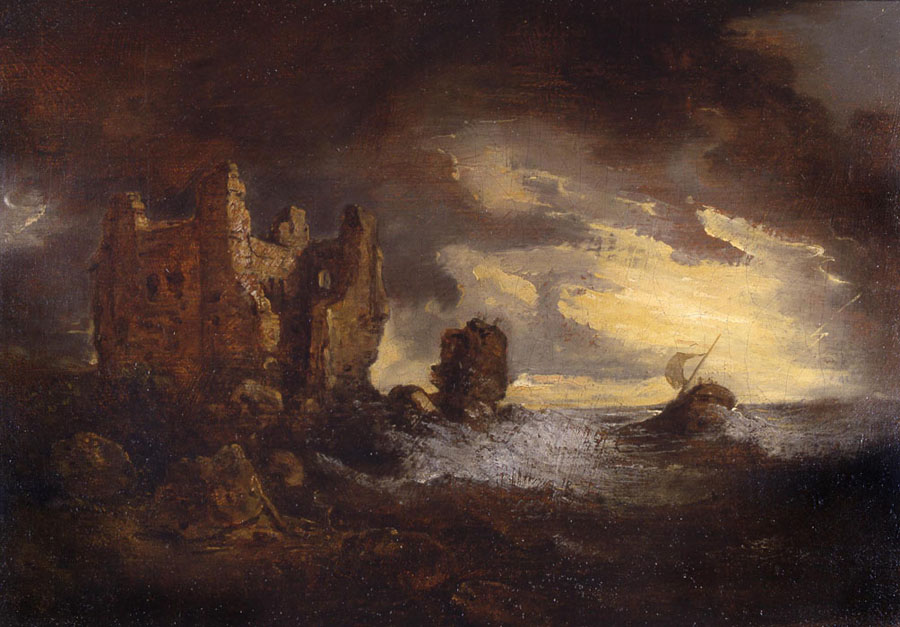 |
| Beaumont, Sir George Howland. (1806). Peele Castle in a Storm. Oil on canvas. |
One day in 1807, William Wordsworth stood before a painting of Peel Castle on the Isle of Man. He realized that he had been there:
from William Wordsworth, Elegiac Stanzas (1807)
I was thy neighbor once, thou rugged Pile!
Four summer weeks I dwelt in sight of thee:
I saw thee every day; and all the while
Thy Form was sleeping on a glassy sea.
Out of this encounter, Wordsworth composed Elegiac Stanzas (1807). Wordsworth contrasts the peaceful conditions of his visit with the tempest depicted by the painter and wonders how he, an artist in a different medium, would have rendered the scene:
Ah! then, if mine had been the Painter’s hand,
To express what then I saw; and add the gleam,
The light that never was, on sea or land,
The consecration, and the Poet’s dream;
I would have planted thee, thou hoary Pile
Amid a world how different from this!
Beside a sea that could not cease to smile;
On tranquil land, beneath a sky of bliss.
The light that never was, on sea or land. For two centuries now, this line has resonated with artists cycling between two tasks: depicting our world and injecting an inner light of the imagination. Wordsworth’s reflection contrasts not only the visions of painter and poet, but also the times of his life. He realizes that with age his vision has grown wiser and darker:
Such, in the fond illusion of my heart,
Such Picture would I at that time have made:
And seen the soul of truth in every part,
A steadfast peace that might not be betrayed.
So once it would have been,—’tis so no more;
I have submitted to a new control:
A power is gone, which nothing can restore;
A deep distress hath humanized my Soul.
Not for a moment could I now behold
A smiling sea, and be what I have been:
The feeling of my loss will ne’er be old;
This, which I know, I speak with mind serene.
So Wordsworth returns to Beaumont’s vision of Peel Castle under very different conditions: “This sea in anger, and that dismal shore.”
O ’tis a passionate Work!—yet wise and well,
Well chosen is the spirit that is here;
That Hulk which labors in the deadly swell,
This rueful sky, this pageantry of fear!
And this huge Castle, standing here sublime,
I love to see the look with which it braves,
Cased in the unfeeling armor of old time,
The lightning, the fierce wind, the trampling waves.
Standing here sublime: here Wordsworth invokes a very old word that was returning to prominence in the Romantic age. In 1757, philosopher Edmund Burke published a treatise contrasting what he saw as distinct aesthetic responses:
The Sublime
The sublime, which suggests infinity, vastness, darkness, solitude, and terror, and inspires a drive to self‐preservation, and the beautiful, which consists in relative smallness, smoothness, and brightness of color, and promotes an instinct for sociability (Sublime and Beautiful).
Wordsworth’s poem contrasts the sublime and the beautiful. He remembered the castle as a lovely, peaceful, pretty sight. In Beaumont’s painting, he encounters a sublime vision of a ruined castle clinging to a rock, beset by turbulence of wind and sea. This is the sublime:
An experience of the sublime characteristically begins with the interposition of an overwhelming force, which shatters equanimity and produces a feeling of blockage. As this power takes hold of mind and emotions, inertia becomes transport: we are hurried on as if “by an irresistible force.” As the experience recedes, it leaves behind a newly invigorated sense of identity and, frequently, admiration for the blocking power (Sublime).
A key component in the sublime is danger, for example heights that project a vision out into infinity. Some people seek sublime encounters with real danger by climbing mountains or parachuting from airplanes. In art, the sublime is an Aesthetic experience, offering the thrill of danger but from a safe distance. Wordsworth is moved by “the lightning, the fierce wind, the trampling waves,” but he stands safely indoors, viewing a painting. Similarly, many people seek simulations of the sublime by riding on scary roller coasters or viewing horror films.
An experience of the sublime opens spiritual portals into the unfathomably distant, the mysteries of infinity. During the Romantic 19th Century, painters opened gateways between our experience of the world and the forces of creation and destruction.
Caspar David Friedrich
Caspar David Friedrich was “ a German Romantic painter who, like Wordsworth, had a quasi-religious feeling for Nature, enhanced by a melancholy cast of mind” (Friedrich, Caspar David). As Wordsworth was responding to Beaumont’s sublime painting, Friedrich intentionally evoked the sublime in visions of grandeur, elevated places and destructive elements. Friedrich’s Wanderer above the Sea of Mist iconically captures the vision of the sublime–looking out into infinity! Sea of Ice portrays the majestic destructiveness of arctic cold. Our perspective here is detached, the aesthetic sublime, but the title informs us that a ship has been lost, the perspectives of its crew drowned by ice and water.
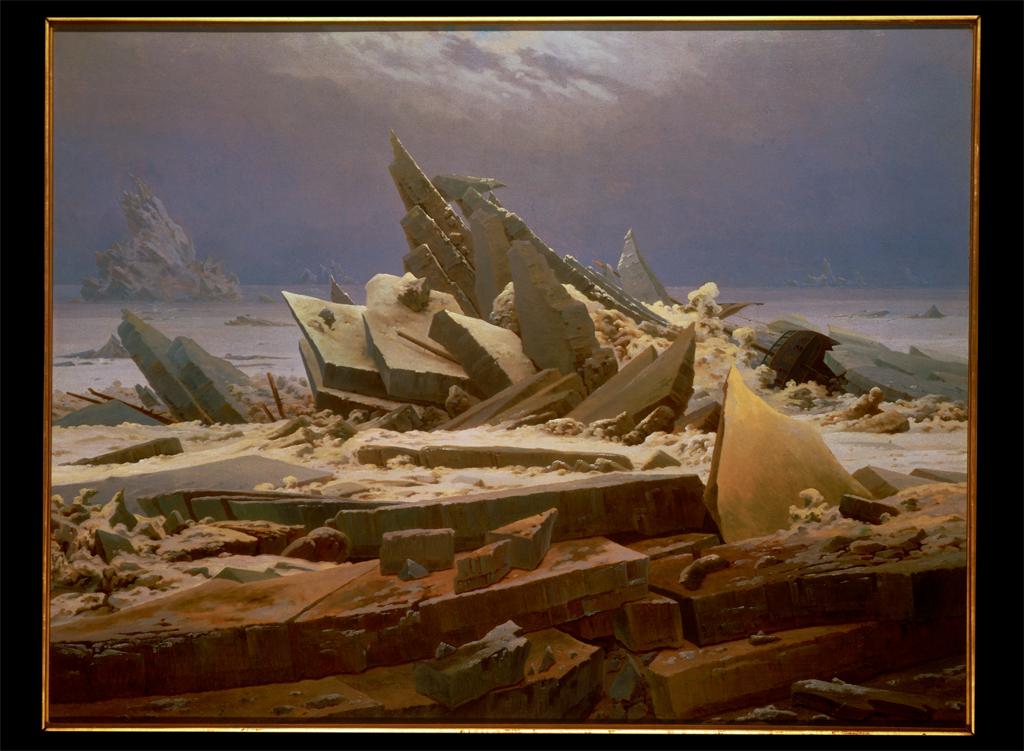 |
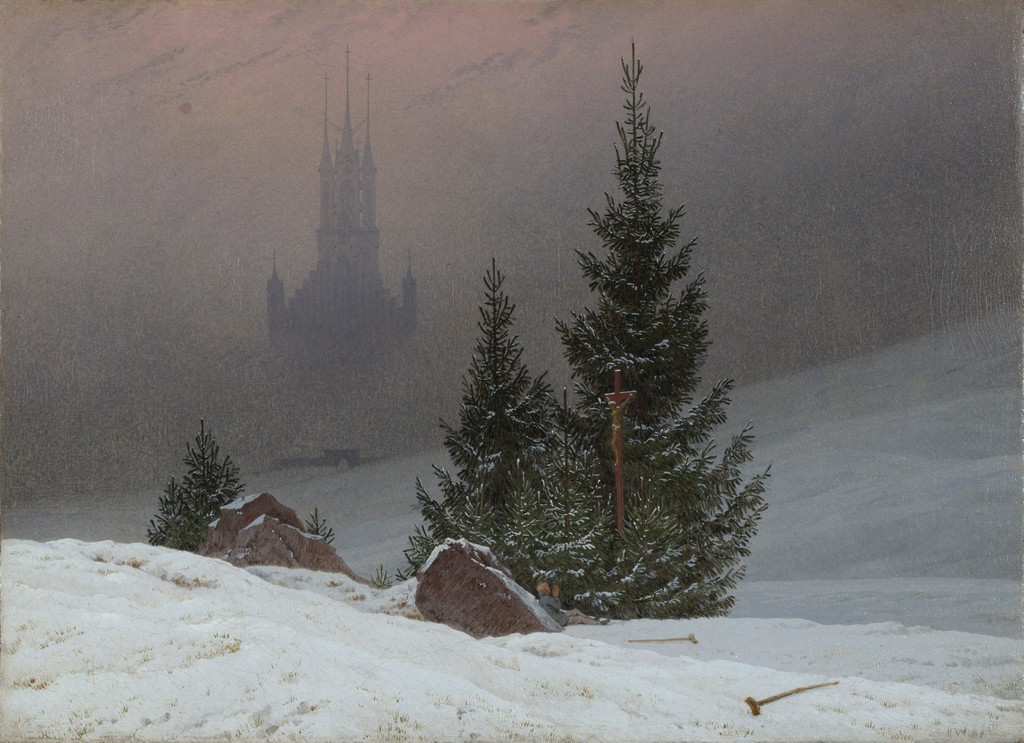 |
||
| Wanderer Above the Sea of Mist. (1818). | Sea of Ice (Arctic Shipwreck). (1824). | Cross on the Mountain (1811). | Winter Landscape. (1811) |
In 1808, [Friedrich] painted the Cross in the Mountains (Dresden) as an altarpiece for a private chapel, although it is a Landscape with a Crucifix rather than a Crucifixion. It started a debate on the propriety of such pantheistic implications. Ruins of Gothic abbeys in woodlands or in the snow, ghostly Gothic cathedrals emerging from mists, the enigmatic Winter landscape (1811: London, NG) with a cripple who has discarded his crutches lying in front of a crucifix in a snowy landscape; or glowing sunsets with figures on the shore silhouetted against the light, all have religious overtones which can be sensed but are only occasionally obvious. (Friedrich, Caspar David).
Frontier Sublime: the Hudson River School
The painterly vogue of seeking the sublime quickly spread to America:
The Hudson River School
a number of American landscape painters, 1825–c.1875, who were inspired by pride in the beauty of their homeland. … [They] painted the Hudson River Valley, the Catskill Mountains, and other remote and untouched areas of natural beauty (Hudson River School).
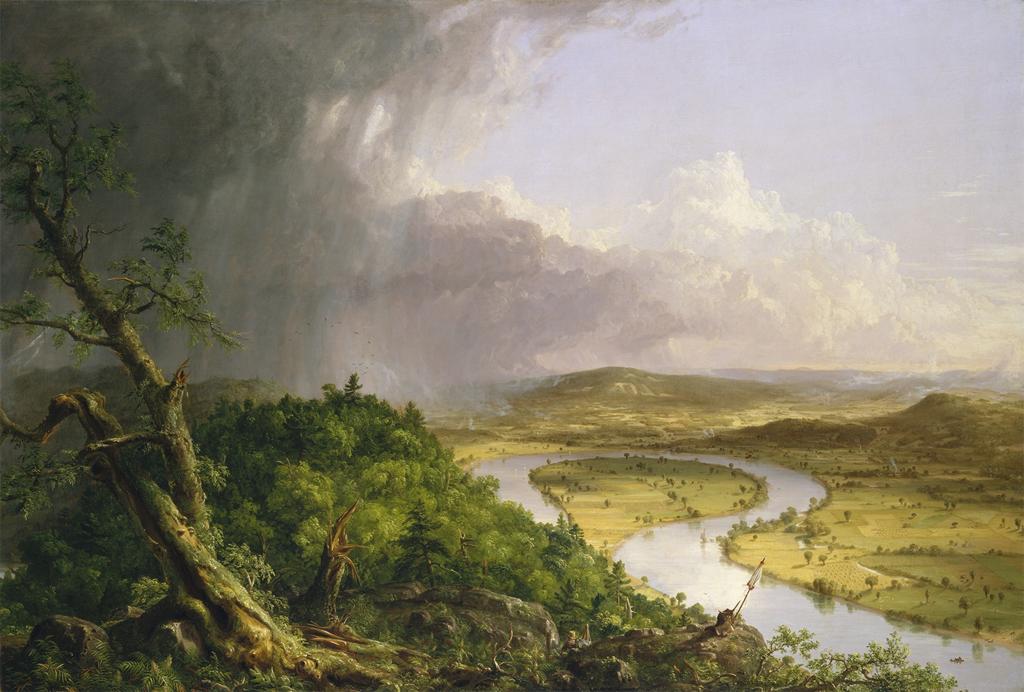 |
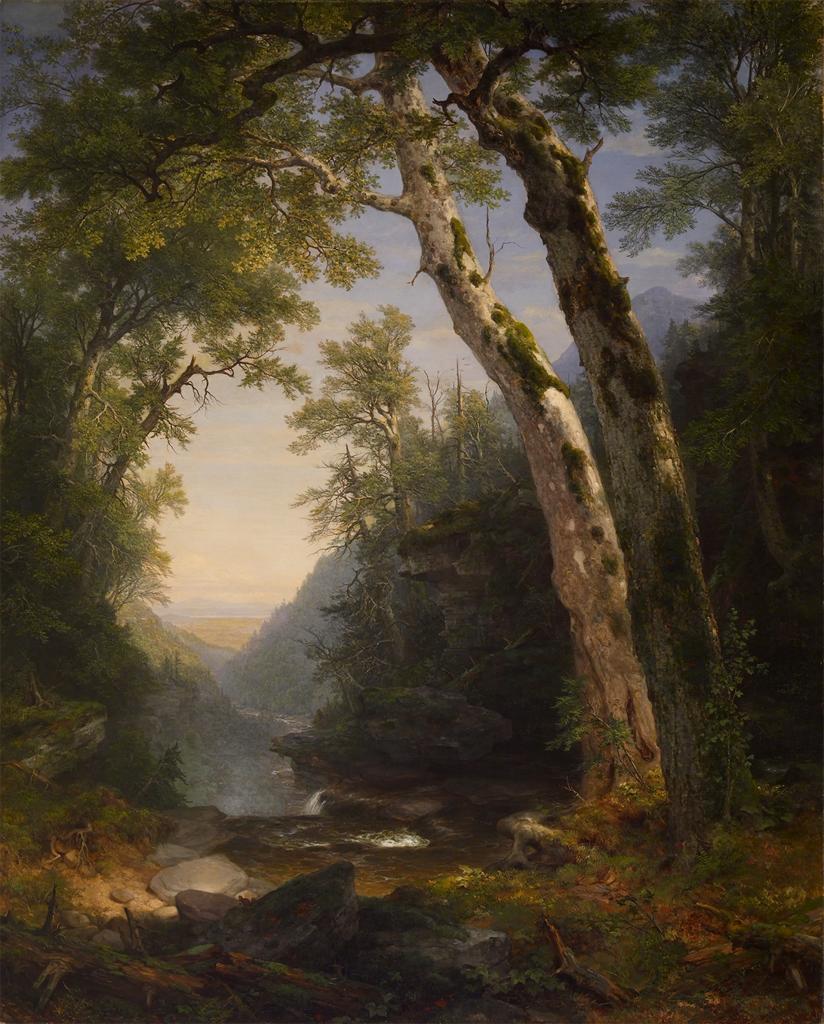 |
| Thomas Cole. (1836). Mount Holyoke after a Thunderstorm-The Oxbow. | Asher Brown Durand. (1859). The Catskills. |
Hudson River painters portrayed mountain and valley vistas from the Catskill mountains. Like Chinese landscape painters, they cultivated the sublime in vast panoramas that dwarfed human figures. In the Oxbow painting above, there is a tiny reference point for human perspective. Can you find it? The parasol on the lower right reaching across the river!
Frederick Edwin Church
As Thomas Cole’s only student, [Frederic Edwin Church] worked as a young man within the context of the Hudson River School. Soon he extended its romantic realism to treat unfamiliar, frequently awesome subjects with grander and more sensuous physical presence. His unusually extensive travels in the Americas, from the Arctic to equatorial South America, provided material for his most notable works, but he also painted views of Europe and the Middle East (Church, Frederic Edwin)
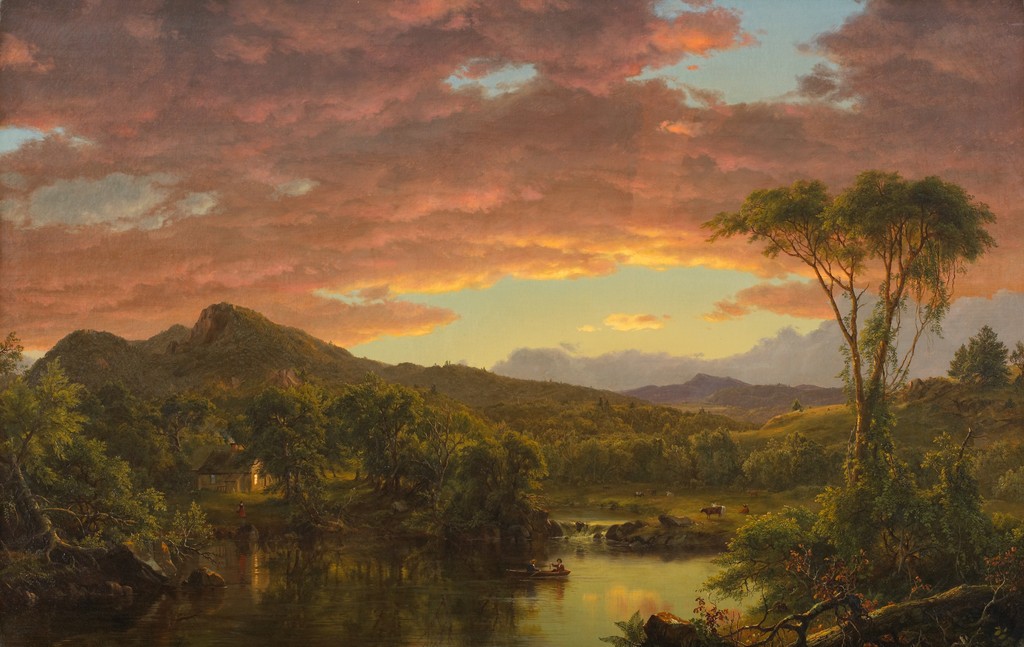 |
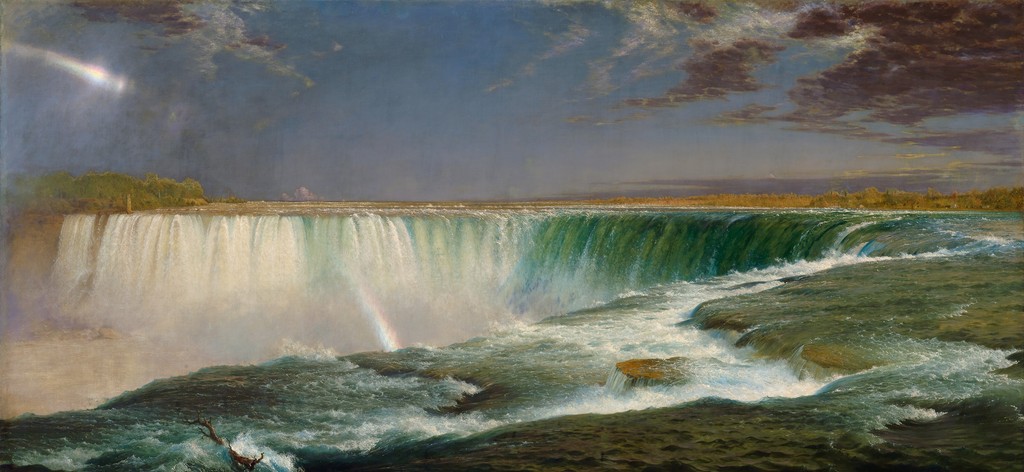 |
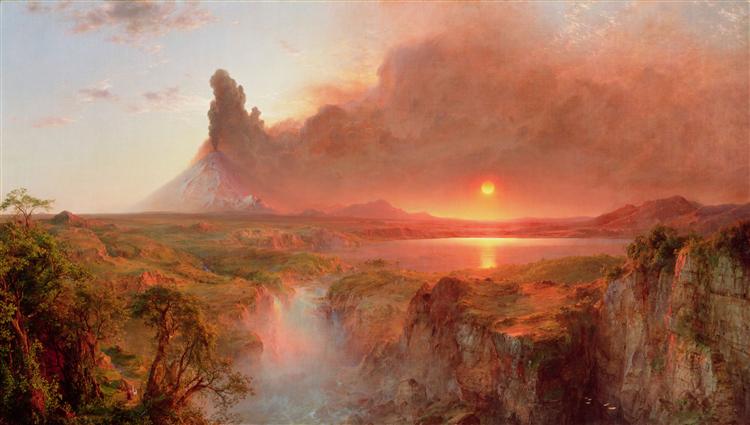 |
| A Country Home. (1854). | Niagara. (1857). | Cotopaxi. (1862). |
Our three samplings from Church’s work move progressively into deeper dimensions of the sublime. A Country Home transforms a typical pastoral scene by pulling back, minimizing the buildings, and drawing our eyes through the opening of the clouds into cosmic light. Niagara places our perspective on the brink of destruction, the sublime force pulling us downward toward the rocks. In Cotopaxi, another waterfall seems to transport us into a primordial moment of time in which the earth itself seems to be newly born.
The Biblical Sublime: Rembrandt
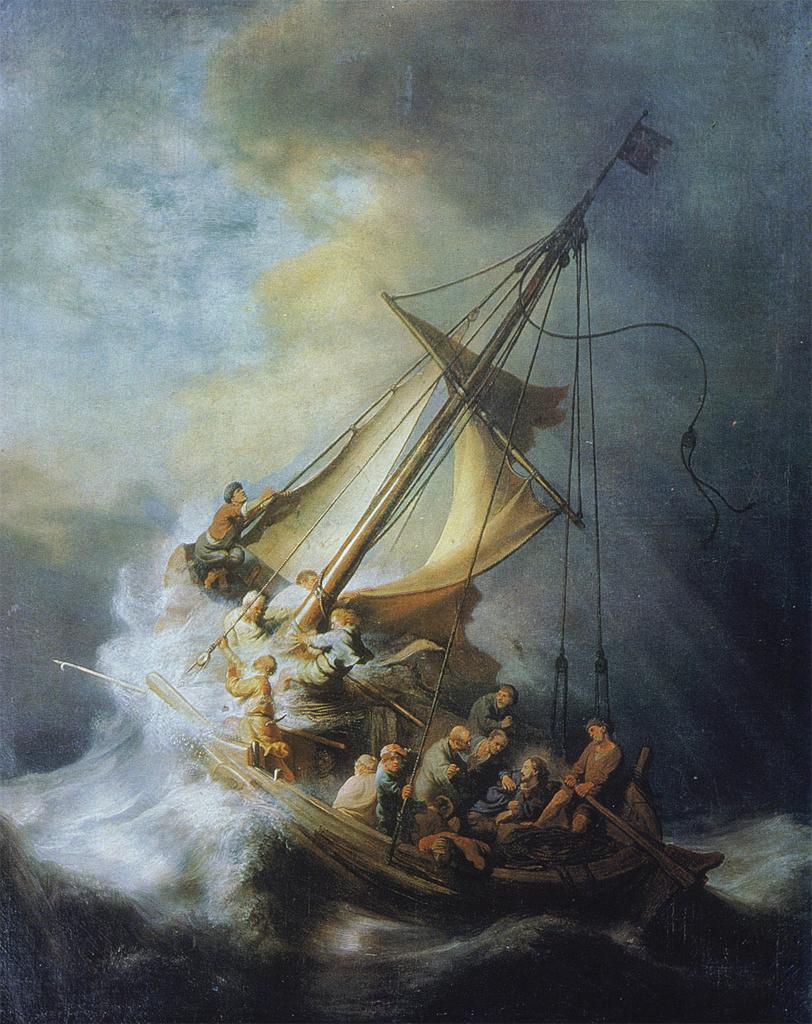 |
| Rembrandt van Rijn. Storm on Sea of Galilee. (1633). Oil on canvas. |
We have explored Rembrandt’s Storm on the Sea of Galilee in terms of technique, e.g. chiaroscuro, composition, etc. Let’s return to it briefly as an example of the sublime. Christians tend to view this painting in biblical terms: an illustration of Jesus’ power and commitment to caring for His children. The title supports that reading. Yet without the title what would we see? A classic example of the sublime: we look safely on as men cling to a frail craft, beset by the turbulence of a storm at sea.
The Existential Sublime: Edvard Munch
At a glance, the work of Edvard Munch seems a far cry from sublime landscapes. You may well be familiar with Scream, a work as popular as it is puzzling. We don’t know anything about this tormented human figure. Unidentified agony distorts the artist’s technique, the shape of the figure’s body, and even the surrounding terrain. What could possibly be this disturbing?
 |
 |
|
| Scream. (11893). Oil, tempera, pastel and crayon on cardboard. | Melancholy. (1895). | Death in the Sickroom. (1892). |
Whatever it is, Melancholy seems to suggest that it pervades Munch’s imagination. Death in the Sickroom invokes the core spiritual issue that troubles people in every human culture: mortality, the specter of one’s own death. And that’s our next focus.
References
Beaumont, Sir George Howland. (1806). Peele Castle in a Storm. [Painting]. Grasmere, Cumbria, UK: Dove Cottage and the Wordsworth Museum. Wikimedia https://commons.wikimedia.org/wiki/File:Sir_George_Howland_Beaumont_-_Peele_Castle_in_a_Strorm.jpg.
Church, F. E. (1854). A Country Home. [Painting]. Seattle, WA: Seattle Art Museum. ID Number 12074. ARTstor https://library-artstor-org.ezproxy.bethel.edu/asset/ASEATTLEIG_10312600010.
Church, F. E. (1857). Niagara. [Painting]. Washington, D.C.: Corcoran Gallery of Art. Accession Number 76.15. ARTstor https://library-artstor-org.ezproxy.bethel.edu/asset/ACORCORANIG_10313504857.
Church, F. E. (1862). Cotopaxi. [Painting]. Detroit, MI: Detroit Institute of Arts. Wikiart https://www.wikiart.org/en/frederic-edwin-church/cotopaxi-1862.
Cole, T. (1836). View from Mount Holyoke, Northampton, Massachusetts, after a Thunderstorm-The Oxbow. [Painting]. New York: Metropolitan Museum of Art. https://library-artstor-org.ezproxy.bethel.edu/asset/MMA_IAP_1039651537.
Durand, A. B. (1859). The Catskills. [Painting]. Baltimore, MD: The Walters Art Museum. ARTstor https://library-artstor-org.ezproxy.bethel.edu/asset/AMICO_WALTERS_103828096.
Friedrich, C. D. (1811). Winter Landscape. [Painting]. London: National Gallery. Accession Number NG6517. ARTstor https://library-artstor-org.ezproxy.bethel.edu/asset/ANGLIG_10313767145.
Friedrich, C. D. (1818). Wanderer Above the Sea of Mist. [Painting]. Hamburg, Germany: Kunsthalle. ARTstor https://library-artstor-org.ezproxy.bethel.edu/asset/AIC_930031.
Friedrich, C. D. (1823 – 1824). Sea of Ice (Arctic Shipwreck). [Painting]. Hamburg, Germany: Hamburger Kunsthalle. ARTstor https://library-artstor-org.ezproxy.bethel.edu/asset/SCALA_ARCHIVES_1039930139
Friedrich, Caspar David, 1774-1840. (1808). Cross on the Mountain. Altarpiece: [Painting]. ARTstor https://library-artstor-org.ezproxy.bethel.edu/#/asset/ARTSTOR_103_41822000653954.
Friedrich, Caspar David. [Article]. (2015). In T. Devonshire Jones, L. Murray, & P. Murray (Ed.s), The Oxford Dictionary of Christian Art and Architecture. Oxford University Press. https://www.oxfordreference.com/view/10.1093/acref/9780199571123.001.0001/m_en_gb0317170.
Hudson River School. [Article]. (2016). In I. Chilvers (Ed.), The Oxford Dictionary of Art and Artists. Oxford University Press. http://www.oxfordreference.com.ezproxy.bethel.edu/view/10.1093/acref/9780191782763.001.0001/acref-9780191782763-e-1173.
Kano, family or school of Japanese painters [Article]. (2018). P. Lagasse & Columbia University. The Columbia encyclopedia (8th ed.). New York, NY: Columbia University Press. http://ezproxy.bethel.edu/login?url=https://search.credoreference.com/content/entry/columency/kano_family_or_school_of_japanese_painters/0?institutionId=712.
Mee, J. (1999). “Blake, William.” In I. McCalman, J. Mee, G. Russell, C. Tuite, K. Fullagar, and P. Hardy (Ed.s), An Oxford Companion to the Romantic Age. Oxford University Press. https://www.oxfordreference.com/view/10.1093/acref/9780199245437.001.0001/acref-9780199245437-e-62.
Rembrandt van Rijn. (1633). Storm on Sea of Galilee. [Painting]. Boston, MA: Isabella Stewart Gardner Museum. Stolen—whereabouts unknown. ARTstor https://library-artstor-org.ezproxy.bethel.edu/asset/ARTSTOR_103_41822000427318.
Songs of Innocence [Article]. (2012). Birch, D., and Hooper, K. (Ed.s), The Concise Oxford Companion to English Literature. Oxford University Press. https://www.oxfordreference.com/view/10.1093/acref/9780199608218.001.0001/acref-9780199608218-e-7078.
Sublime and Beautiful, A Philosophical Enquiry into the Origin of our Ideas of the. [Article]. (2009). In D. Birch, D. (Ed.), The Oxford Companion to English Literature. Oxford University Press. https://www.oxfordreference.com/view/10.1093/acref/9780192806871.001.0001/acref-9780192806871-e-7265.
Sublime. [Article]. (1999). In I. McCalman, J. Mee, G. Russell, C. Tuite, K. Fullagar, and P. Hardy (Ed.), An Oxford Companion to the Romantic Age. Oxford University Press. http://www.oxfordreference.com.ezproxy.bethel.edu/view/10.1093/acref/9780199245437.001.0001/acref-9780199245437-e-676.
Wordsworth, W. (1807). Elegiac Stanzas Elegiac Stanzas Suggested by a Picture of Peele Castle in a Storm, Painted by Sir George Beaumont. In Poems, in Two Volumes. https://www.poetryfoundation.org/poems/45516/elegiac-stanzas-suggested-by-a-picture-of-peele-castle-in-a-storm-painted-by-sir-george-beaumont.
William Wordsworth [Article]. (n.d.). Poetry Foundation https://www.poetryfoundation.org/poets/william-wordsworth.
an aesthetic effect in art that suggests "infinity, vastness, darkness, solitude, and terror, and inspires a drive to self‐preservation, and the beautiful, which consists in relative smallness, smoothness, and brightness of color, and promotes an instinct for sociability (Sublime and Beautiful).
a particular set of values regarding art, taste, and the subjective experience of beauty, ugliness, the sublime, etc. A culture, a school of artists, an individual artist, or an audience can be said to have an aesthetic
